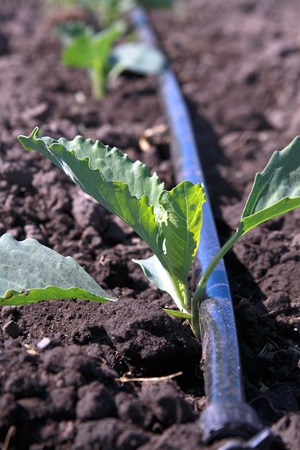Georgie Smith pulls her truck up to a patch of land and surveys a field through her window.
What normally would be a lush display of green row crops this time of year instead is a lot of brown dirt and scattered remnants of a costly crop failure.
“This is my bean field,” Smith said. “It’s pretty sad.”
Smith is like every farmer on the fertile soil of Ebey’s Prairie on Whidbey Island coping with an unusually dry stretch of weather this year.
The months of May and June have produced little rainfall through Central and North Whidbey, which has reduced yields and left some dry land farmers that rely on rain such as Smith scrambling for creative ways to irrigate their crops.
She said she’s spent about $2,500 more on drip hose this year than in typical years.
But that didn’t help her Rockwell Bean crop that she planted in late May that depended on help from the sky to keep the seedlings moist.
The lack of water cost her about 80 percent of the heirloom bean plants, which she was planning to replant. A fungal disease known as rust hurt the size of her garlic, another one of her Willowood Farm staples.
“We’re going to take a financial hit, that’s for sure,” Smith said, guessing the losses in sales could be $30,000-$40,000. “I do grow a lot of crops. Hopefully, it will even out.”
Smith’s farm includes a small pond that collects rainwater and is used for irrigation.
Wilbur and Julieanna Purdue of Prairie Bottom Farm, also on the prairie, use water collected from a series of rain barrels but this year resorted to tapping into their water from the Town of Coupeville.
“We’re trying something we’ve never done with drip tape,” Wilbur Purdue said.
“Every year is a different challenge. This year it’s a dry challenge.”
The Purdues are taking advantage of the warm weather by trying out crops that favor drier conditions.
Most of Smith’s crops also are benefitting from the extra sun.
Dale Sherman of Sherman’s Pioneer Farm Produce has no complaints so far.
“Weatherwise, I’m probably one of the only farmers over here that’s thinking this is pretty cool because my squash and my pumpkins are just growing like wildfire,” he said.
Still, Sherman knows that prolonged dryness could have adverse effects and realizes the traditional warmer months are yet to come.
Rainfall in Coupeville was .23 inches in May and .53 inches in June, according to readings taken by the town’s public works department.
The warm weather resulted in earlier cuttings of hay crops. But earlier doesn’t always mean better.
“We’ve seen a reduction in yield because of dry conditions,” said Central Whidbey farmer Don Sherman.
The dry weather also has caused strawberry and blueberry season to arrive a few weeks earlier than usual.
In the case of Bell’s Farm, a strawberry season that traditionally lasts through the Fourth of July holiday weekend is already done for the season.
The strawberry and vegetable farm opened for the you-pick season on May 28, the earliest that farm co-owner Frank Mueller can remember since the 1970s.
Claire Lichtenfels of Huntersmoon Blueberries on North Whidbey said their late season blueberries are well ahead of schedule and should be ripe by the middle of July at the latest. Normally, that doesn’t happen until August.
It’s been a strange year for growers with a mixture of favorable and poor results.
“This is getting to be a serious situation for farmers,” said Karen Bishop of the Whidbey Conservation District. “The vegetable row croppers who are very dependent on interspersed summer rains, especially in June, are scrambling for water. They do consecutive plantings of crops, especially greens — lettuce, spinach — to provide a consistent supply for consumers. Germination is a real problem with such sparse soil moisture.”
As most farmers, Smith did her homework by checking the seasonal forecasts.
“I looked at the numbers,” she said. “I wasn’t imagining this. It is really dry. But what can you do? You keep going and hope next year is better. It’s what farmers do. We’re the ultimate gamblers.”



